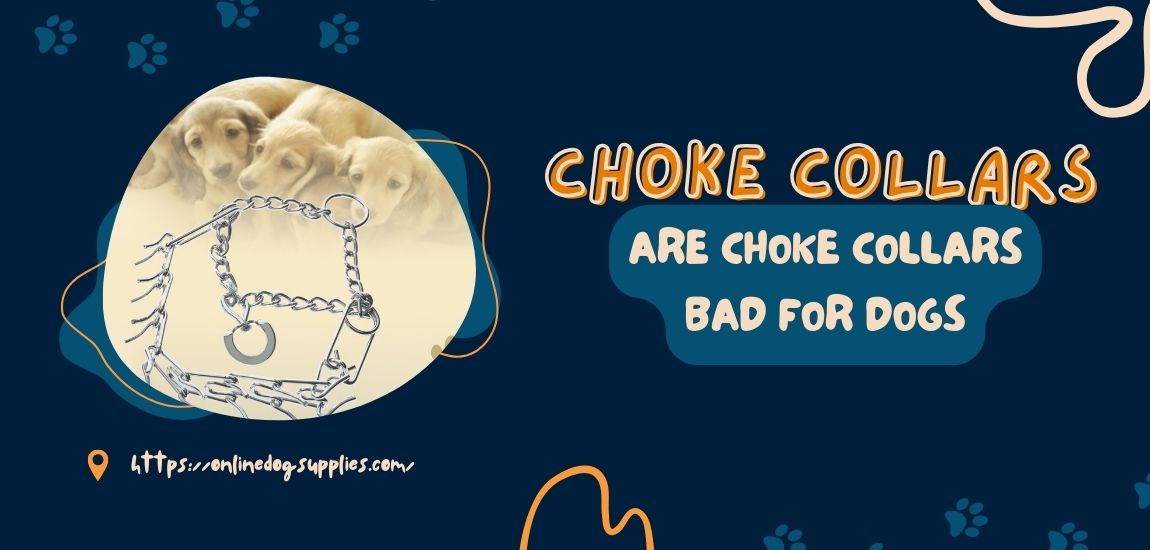Hey there, fellow dog lovers! If you’ve ever walked down the pet aisle or browsed online for dog training gear, chances are you’ve come across choke collars. These collars, also known as slip collars or chain collars, have sparked quite a debate in the dog community. Are they effective training tools or harmful devices that should be avoided? Let’s dive in and explore the truth behind the are choke collars bad for dogs.
What Exactly is a Choke Collar?
Before we delve into whether choke collars are good or bad for dogs, let’s first understand what they are. Choke collars are designed to tighten around a dog’s neck when tension is applied, such as when the dog pulls on the leash or the handler gives a correction. They are typically made of metal chain links or nylon webbing and come in various sizes to fit different breeds.
Pros of Choke Collars:
- Effective Training Tool: Proponents of choke collars argue that when used correctly, they can be effective in teaching dogs to walk politely on a leash and discourage pulling behavior.
- Immediate Feedback: Unlike other training methods that rely on verbal commands or treats, choke collars provide immediate feedback to the dog when they pull, making it easier for them to understand the desired behavior.
- Versatility: Choke collars can be used for dogs of all sizes and breeds, making them a versatile option for training.
Cons of Choke Collars:
- Risk of Injury: One of the main concerns with choke collars is the potential for injury to the dog’s neck, throat, or trachea, especially if they are used incorrectly or by inexperienced handlers.
- Negative Association: Some argue that choke collars can create a negative association between the handler and the dog, leading to fear or anxiety during training sessions.
- Not Suitable for All Dogs: Choke collars may not be suitable for dogs with certain health conditions, such as respiratory issues or neck injuries, as they can exacerbate these problems.
Alternatives to Choke Collars:
- Martingale Collars: Martingale collars provide a gentler alternative to choke collars, as they tighten slightly when tension is applied but do not constrict fully like choke collars.
- Harnesses: Harnesses distribute pressure more evenly across the dog’s body, reducing the risk of neck injuries and providing better control, especially for dogs prone to pulling.
- Positive Reinforcement Training: Positive reinforcement training focuses on rewarding desired behaviors with treats or praise, rather than punishing undesirable behaviors, and is effective in training dogs without the need for aversive tools like choke collars.
Conclusion
So, are choke collars bad for dogs? Like many things in the dog world, the answer isn’t black and white. While choke collars can be effective training tools when used correctly, they also come with risks and limitations. As responsible dog owners, it’s essential to weigh the pros and cons carefully and consider alternative training methods that prioritize the safety and well-being of our furry friends. Remember, every dog is unique, so what works for one may not work for another. Let’s continue to educate ourselves and explore humane and effective ways to train and bond with our canine companions. Happy training!
FAQs about choke collars for dogs
Are choke collars cruel?
Choke collars can be cruel if used improperly, causing injury to a dog’s neck or throat.
Can choke collars cause long-term damage?
Yes, improper use of choke collars can lead to long-term damage to a dog’s neck or throat.
What are alternatives to choke collars?
Alternatives include martingale collars, harnesses, and positive reinforcement training methods.
At what age can I use a choke collar?
Wait until your dog is at least six months old before using a choke collar for training.
How do I fit a choke collar properly?
Ensure it sits high on your dog’s neck, snug but not tight, with room for two fingers between the collar and neck.


